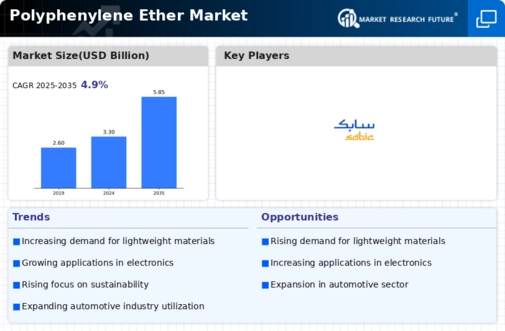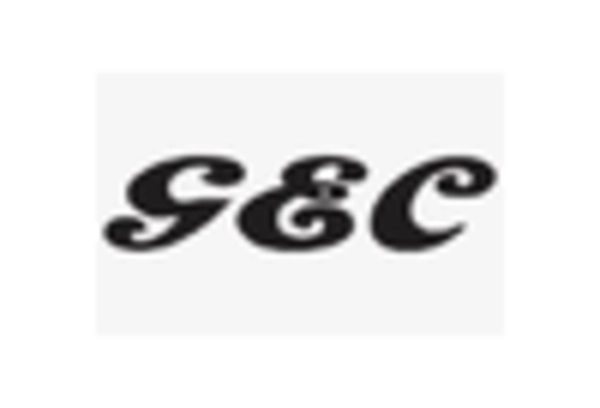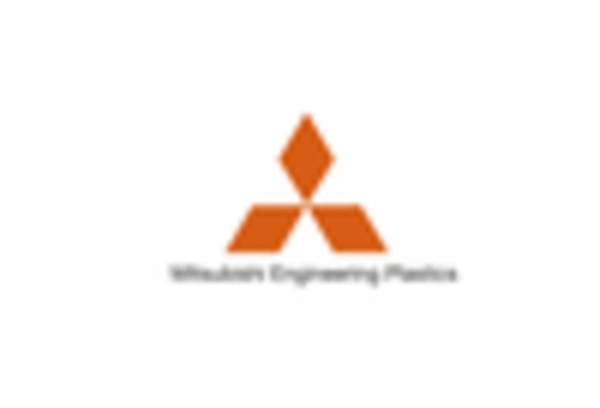-
Executive Summary
-
Scope of the Report
-
Market Definition
-
Scope of the Study
- Research Objectives
- Assumptions & Limitations
-
Market Structure
-
Market
-
Research Methodology
-
Research Process
-
Secondary Research
-
Primary Research
-
Forecast Model
-
Market Landscape
-
Five Forces Analysis
-
of Buyers
-
Ether Market
-
Threat of New Entrants
-
Bargaining Power
-
Bargaining Power of Suppliers
-
Threat of Substitutes
-
Segment Rivalry
-
Value Chain/Supply Chain of Global Polyphenylene
-
Industry Overview of Global Polyphenylene Ether Market
-
Introduction
-
Growth Drivers
-
Impact Analysis
-
Market
-
Challenges
-
Market Trends
-
Introduction
-
Growth Trends
-
Impact Analysis
-
Global Polyphenylene Ether Market, by Type
-
Introduction
-
PPE/PA (polyamide)
- Market Estimates &
- Market Estimates & Forecast, by Region,
-
Forecast, 2020–2027
-
PPE/PP (polypropylene)
- Market Estimates &
- Market Estimates & Forecast, by Region,
-
Forecast, 2020–2027
-
PPE/PS (polystyrene)
- Market Estimates &
- Market Estimates & Forecast, by Region,
-
Forecast, 2020–2027
-
Others
- Market Estimates & Forecast, 2020–2027
- Market Estimates & Forecast, by Region, 2020–2027
-
Global Polyphenylene Ether Market, by Application
-
Introduction
- Market Estimates & Forecast, 2020–2027
-
Automotive
-
Market Estimates & Forecast, by Region, 2020–2027
-
Electrical
- Market Estimates & Forecast, 2020–2027
-
and electronics
-
Market Estimates & Forecast, by Region, 2020–2027
-
Healthcare
- Market Estimates & Forecast, 2020–2027
- Market Estimates
-
& Forecast, by Region, 2020–2027
-
Aerospace
- Market
- Market Estimates & Forecast,
-
Estimates & Forecast, 2020–2027
-
by Region, 2020–2027
-
Others
- Market Estimates & Forecast,
- Market Estimates & Forecast, by Region, 2020–2027
-
Global Polyphenylene Ether Market, by Region
-
Introduction
-
North America
- Market Estimates & Forecast, 2020–2027
- Market Estimates & Forecast, by Type, 2020–2027
- Market
- US
- Canada
-
Estimates & Forecast, by Application, 2020–2027
-
Market Estimates & Forecast, 2020–2027
-
Forecast, by Type, 2020–2027
-
by Application, 2020–2027
-
& Forecast, 2020–2027
-
Type, 2020–2027
-
Europe
- Market Estimates & Forecast, 2020–2027
- Market Estimates & Forecast, by Type, 2020–2027
- Market
- Germany
- France
- Italy
-
Estimates & Forecast, by Application, 2020–2027
-
& Forecast, by Type, 2020–2027
-
by Application, 2020–2027
-
& Forecast, 2020–2027
-
Type, 2020–2027
-
Market Estimates & Forecast, by Application, 2020–2027
-
& Forecast, by Type, 2020–2027
-
by Application, 2020–2027
-
Forecast, 2020–2027
-
Spain
-
Market Estimates & Forecast, 2020–2027
-
Market Estimates
-
Market Estimates & Forecast,
-
UK
-
Market Estimates &
-
Market Estimates & Forecast, by Type,
-
Market Estimates & Forecast, by Application, 2020–2027
-
Russia
-
Market Estimates & Forecast, 2020–2027
-
Market Estimates & Forecast, by Type, 2020–2027
-
Market Estimates & Forecast, by Application, 2020–2027
-
Estimates & Forecast, by Type, 2020–2027
-
& Forecast, by Application, 2020–2027
-
Market Estimates & Forecast, 2020–2027
-
Forecast, by Type, 2020–2027
-
Application, 2020–2027
-
Forecast, 2020–2027
-
Poland
-
Market Estimates & Forecast, 2020–2027
-
Market
-
Market Estimates
-
Asia-Pacific
- Market Estimates &
- Market Estimates & Forecast, by
- China
- India
-
Market Estimates & Forecast, by Type, 2020–2027
-
& Forecast, by Application, 2020–2027
-
Estimates & Forecast, 2020–2027
-
by Type, 2020–2027
-
New Zealand
-
Market Estimates
-
Japan
-
Market
-
Market Estimates & Forecast,
-
Market Estimates & Forecast, by Application,
-
Australia
-
Market Estimates & Forecast,
-
Market Estimates & Forecast, by Type, 2020–2027
-
Market Estimates & Forecast, by Application, 2020–2027
-
Market Estimates & Forecast, 2020–2027
-
Market Estimates & Forecast, by Type, 2020–2027
-
& Forecast, by Application, 2020–2027
-
& Forecast, by Type, 2020–2027
-
by Application, 2020–2027
-
Estimates & Forecast, 2020–2027
-
by Type, 2020–2027
-
Israel
-
Market Estimates
-
Rest of Asia-Pacific
-
Market Estimates & Forecast, 2020–2027
-
Market Estimates
-
Market Estimates & Forecast,
-
Middle East & Africa
- Market
- Market Estimates & Forecast,
- Market Estimates & Forecast, by Application,
- Turkey
-
Market Estimates & Forecast, by Type, 2020–2027
-
& Forecast, by Application, 2020–2027
-
Market Estimates & Forecast, 2020–2027
-
Forecast, by Type, 2020–2027
-
by Application, 2020–2027
-
Forecast, 2020–2027
-
Forecast, 2020–2027
-
Estimates & Forecast, by Application, 2020–2027
-
& Forecast, by Type, 2020–2027
-
by Application, 2020–2027
-
& Forecast, 2020–2027
-
Type, 2020–2027
-
Rest of Latin America
-
Market Estimates
-
North Africa
-
Market Estimates &
-
Market Estimates & Forecast,
-
GCC
-
Market Estimates &
-
Market Estimates & Forecast, by Type,
-
Market Estimates & Forecast, by Application, 2020–2027
-
Rest of the Middle East & Africa
-
Market Estimates &
-
Market Estimates & Forecast, by Type,
-
Market Estimates & Forecast, by Application, 2020–2027
-
Latin America
- Market Estimates & Forecast, 2020–2027
- Market Estimates & Forecast, by Type, 2020–2027
- Market
- Brazil
- Argentina
- Mexico
-
Market Estimates & Forecast, by Application, 2020–2027
-
Company
-
Landscape
-
Company Profiles
-
Asahi Kasei Corporation
- Type/Business Segment Overview
- Financial
- Key Developments
-
Company Overview
-
Updates
-
BASF SE
- Company Overview
- Type/Business Segment Overview
- Financial Updates
-
Key Developments
-
Evonik Industries AG
- Company Overview
- Type/Business Segment Overview
- Financial Updates
-
Key Developments
-
Entec Polymers
- Company Overview
- Financial Updates
- Key Developments
-
Type/Business Segment Overview
-
LyondellBasell Industries Holdings B.V.
- Company Overview
- Financial Updates
- Key Developments
-
Type/Business Segment Overview
-
Mitsubishi Chemical Corporation
- Company Overview
- Financial Updates
- Key Developments
-
Type/Business Segment Overview
-
Oxford Polymers
- Company Overview
- Type/Business Segment
- Financial Updates
- Key Developments
-
Overview
-
Polyplastics
- Company Overview
- Type/Business Segment Overview
- Financial Updates
- Key Developments
-
Co. Ltd
-
SABIC
- Type/Business Segment Overview
- Financial
- Key Developments
-
Company Overview
-
Updates
-
Sumitomo Chemical Co., Ltd.
- Type/Business Segment Overview
- Financial
- Key Developments
-
Company Overview
-
Updates
-
Ashley Polymers, Inc
- Type/Business Segment Overview
- Financial
- Key Developments
-
Company Overview
-
Updates
-
Bluestar New Chemical Materials
- Company Overview
- Type/Business Segment Overview
- Financial Updates
- Key Developments
-
Co., Ltd
-
Nagase America
- Company Overview
- Type/Business Segment Overview
- Financial Updates
- Key Developments
-
Corporation
-
Conclusion
-
LIST OF TABLES
-
World Population in Major Regions (2020–2030)
-
Global Polyphenylene Ether Market, by Region, 2020–2027
-
Table
-
North America: Polyphenylene Ether Market, by Country, 2020–2027
-
Table
-
Europe: Polyphenylene Ether Market, by Country, 2020–2027
-
Asia-Pacific:
-
Polyphenylene Ether Market, by Country, 2020–2027
-
Middle East
-
& Africa: Polyphenylene Ether Market, by Country, 2020–2027
-
Table
-
Latin America: Polyphenylene Ether Market, by Country, 2020–2027
-
Table
-
Global Polyphenylene Ether Type Market, by Region, 2020–2027
-
Table
-
North America: Polyphenylene Ether Type Market, by Country, 2020–2027
-
Europe: Polyphenylene Ether Type Market, by Country, 2020–2027
-
Table11 Asia-Pacific: Polyphenylene Ether Type Market, by Country, 2020–2027
-
Table13 Middle East & Africa: Polyphenylene Ether Type Market, by Country,
-
Table12 Latin America: Polyphenylene Ether Type Market, by
-
Country, 2020–2027
-
Table14 North America: Polyphenylene Ether Application
-
Market, by Country, 2020–2027
-
Table13 Europe: Polyphenylene Ether Application
-
Market, by Country, 2020–2027
-
Table14 Asia-Pacific: Polyphenylene Ether
-
Application Market, by Country, 2020–2027
-
Table16 Middle East & Africa:
-
Polyphenylene Ether Application Market, by Country, 2020–2027
-
Table15
-
Latin America: Polyphenylene Ether Application Market, by Country, 2020–2027
-
Table23 Global Type Market, by Region, 2020–2027
-
Table24 Global
-
Application Market, by Region, 2020–2027
-
Table25 North America: Polyphenylene
-
Ether Market, by Country, 2020–2027
-
Table26 North America: Polyphenylene
-
Ether Market, by Type, 2020–2027
-
Table27 North America: Polyphenylene
-
Ether Market, by Application, 2020–2027
-
Table28 Europe: Polyphenylene
-
Ether Market, by Country, 2020–2027
-
Table29 Europe: Polyphenylene Ether
-
Market, by Type, 2020–2027
-
Table30 Europe: Polyphenylene Ether Market,
-
by Application, 2020–2027
-
Table31 Asia-Pacific: Polyphenylene Ether
-
Market, by Country, 2020–2027
-
Table32 Asia-Pacific: Polyphenylene Ether
-
Market, by Type, 2020–2027
-
Table33 Asia-Pacific: Polyphenylene Ether
-
Market, by Application, 2020–2027
-
Table36 Middle East & Africa:
-
Polyphenylene Ether Market, by Country, 2020–2027
-
Table37 Middle East
-
& Africa Polyphenylene Ether Market, by Type, 2020–2027
-
Table33
-
Middle East & Africa: Polyphenylene Ether Market, by Application, 2020–2027
-
Table34 Latin America: Polyphenylene Ether Market, by Country, 2020–2027
-
Table35 Latin America Polyphenylene Ether Market, by Type, 2020–2027
-
Table33 Latin America: Polyphenylene Ether Market, by Application, 2020–2027
-
LIST OF FIGURES
-
Global Polyphenylene Ether Market Segmentation
-
Forecast Methodology
-
Five Forces Analysis of Global Polyphenylene
-
Ether Market
-
Value Chain of Global Polyphenylene Ether Market
-
FIGURE
-
Share of Global Polyphenylene Ether Market in 2020, by Country (%)
-
FIGURE
-
Global Polyphenylene Ether Market, 2020–2027,
-
Sub-Segments
-
of Type, 2020
-
Global Polyphenylene Ether Market Size, by Type, 2020
-
Share of Global Polyphenylene Ether Market, by Type, 2020–2027
-
Sub-Segments of Application
-
Global Polyphenylene Ether
-
Market Size, by Application, 2020
-
Share of Global Polyphenylene Ether
-
Market, by Application, 2020–2027

















Leave a Comment